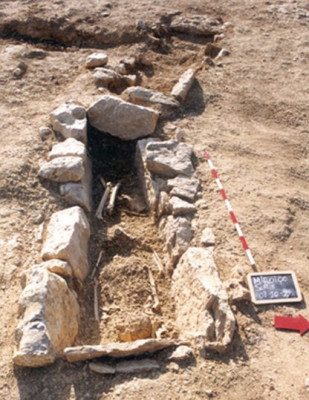Choose locations to explore
Select the desired period of history
6th century BC - 7th century AD
Roman villa of Miroiço
Roman villa, occupied between the 1st century BC and 6th century AD (possibly until the Islamic Medieval period), in an area of high farming potential, overlooking the Caparide river. Remains were largely from waste areas - no structures corresponding to the villa's pars urbana and/or pars rustica were found, other than a ceramic oven, probably Roman. The best-known occupation in the area corresponds to the necropolis, where 33 graves were studied, including one incineration grave from the High-Imperial era. The remaining inhumation graves are from the Low-Imperial era and Late Antiquity, and open directly in the ground (in some cases delimited by lateral braces forming rectangular boxes). An anthropological study determined the minimum number of individuals: 49 adults and 28 non-adults, distributed in individual graves and ossuaries. Most skeletons were found in dorsal decubitus (lying on the back), with burials oriented towards the east.
Typology
Rural property | Villa / Casal, Necropolis, Oven
Archeological interventions
1999
Suggested reading
Oliveira, F. de P.(1888-1892) - Antiquités préhistoriques et romaines des environs de Cascaes. Lisboa: [s.n.].
Encarnação, J. d' (1968) - Notas sobre alguns vestígios romanos no Concelho de Cascais. Estoril: Junta de Turismo da Costa do Sol.
Cardoso, G. (1991) - Carta arqueológica do Concelho de Cascais. Cascais: Câmara Municipal de Cascais.
Encarnação, J.(2005) - A presença romana em Cascais: um território da Lusitânia ocidental. Lisboa: Museu Nacional de Arqueologia. Cascais: Câmara Municipal de Cascais.
Cardoso, G.; Encarnação, J.(2010) - Roteiros do Património da Cascais: Património Arqueológico. Cascais: Câmara Municipal de Cascais.
Encarnação, J. d' (1968) - Notas sobre alguns vestígios romanos no Concelho de Cascais. Estoril: Junta de Turismo da Costa do Sol.
Cardoso, G. (1991) - Carta arqueológica do Concelho de Cascais. Cascais: Câmara Municipal de Cascais.
Encarnação, J.(2005) - A presença romana em Cascais: um território da Lusitânia ocidental. Lisboa: Museu Nacional de Arqueologia. Cascais: Câmara Municipal de Cascais.
Cardoso, G.; Encarnação, J.(2010) - Roteiros do Património da Cascais: Património Arqueológico. Cascais: Câmara Municipal de Cascais.
Address
Miroiço, Manique, Cascais
Useful links
Cascais Culture - Archaeological Heritage - https://cultura.cascais.pt/listagens/patrimonio-arqueologico
Identification code
LxR1105071
Cookies
All cookies used by www.lisboaromana.pt website are for the technical storage or transmission of communication through an electronic communications network.
The website www.lisboaromana.pt also uses language cookies for website users. These cookies have a duration of one year. See our Cookie policy
